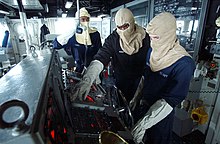

Anti-flash gear, also known simply as flash gear, is basic personal protective equipment consisting of a fire-resistant hood and fire-resistant gloves, [1] nowadays often made of Nomex.
Contents
Anti-flash gear protects to the head, neck, face and hands from short-duration flame exposure and heat. This equipment is donned by shipboard navy personnel whenever a fire breaks out or during periods of heightened readiness. [1]